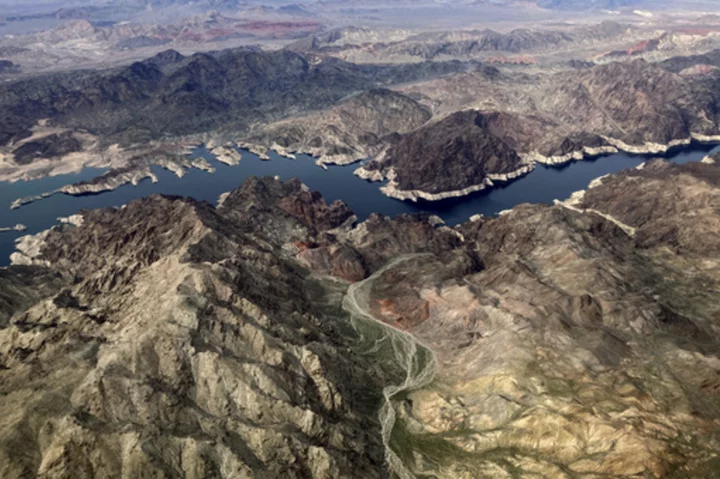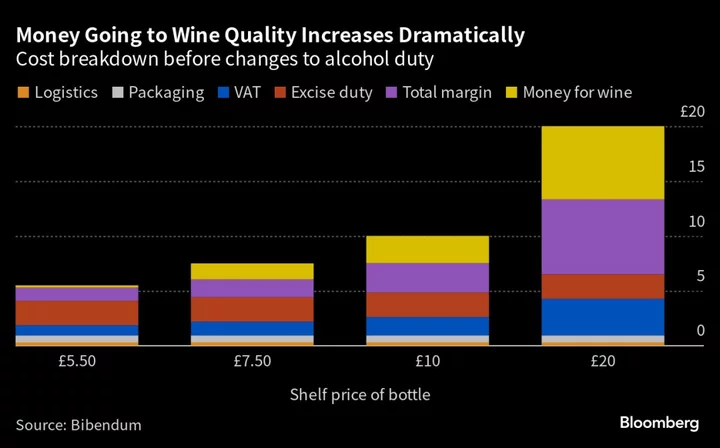WASHINGTON (AP) — Federal officials this week are expected to ease water cuts for 2024 under a slightly improved outlook for the Colorado River’s health, though long-term challenges remain.
The river provides water for seven U.S. states, 29 Native American tribes and two states in Mexico. It also supports a multibillion-dollar farm industry in the West and generates hydropower used across the region. Years of overuse by farms and cities and the effects of drought worsened by climate change has meant much less water flows today through the Colorado River than in previous decades.
The U.S. government in 2021 announced cuts that hit Arizona particularly hard. Last year, those cuts grew more severe thanks to continued drought, poor precipitation and less runoff from the river's Rocky Mountains source.
A wetter winter and conservation measures have helped improve the river's health a bit this summer, but experts warn a drier future is ahead.
WHAT CUTS ARE EXPECTED?
The Bureau of Reclamation will describe the Colorado River's status based on projected water levels at Lake Powell and Lake Mead, key reservoirs that serve as barometers of the river's health. Officials are expected to announce cuts for next year to some basin states.
The cuts are based on previous agreements to keep Lake Mead from getting too low.
Bountiful snowfall and rain last winter pulled much of the region out of drought this spring and raised water levels at reservoirs.
State water officials expect a return to what was announced in 2021, a “Tier 1” shortage. That means Arizona would see an 18% cut from it’s total water allocation, down slightly from last year. Farmers will face the brunt of the forced cuts while cities and tribes will be spared, though some have already volunteered to cut back in exchange for federal money.
Nevada, which gets far less river water than Arizona and California, is expected to lose slightly less than it did last year. Mexico is expected to face a 5% reduction.
California has not faced any forced water cuts.
WILL THE RIVER KEEP GETTING HEALTHIER?
No. While the winter's precipitation brought immediate relief, the challenges of a hotter, drier future and overuse of the river remain.
Lake Powell and Lake Mead are still only about 39% and 33% full, respectively.
“That is a little better than last year, but still extremely low. It only takes a few dry years to set us back,” said Kim Mitchell, senior water policy advisor at Western Resource Advocates, a Phoenix-based nonprofit dedicated to protecting water and land in the West.
ARE DEEPER CUTS COMING?
Yes, but not immediately. This week's announcement is just one piece of various water-savings plans already in place or being negotiated.
Earlier this year, Arizona, California and Nevada released a plan to conserve an additional 3 million acre-feet of water through 2026 in exchange for $1.2 billion from the federal government. An acre-foot of water is enough to serve 2-3 households annually. The Interior Department is expected to release its analysis of the proposal this fall.
The plan, likely be finalized in 2024, would mean cuts for California's Imperial Irrigation District, the largest user of Colorado River water. The district, which supplies farmers who grow fruits, vegetables and feed crops, is typically spared based on senior water rights.
Some tribes and individual districts in the West that supply water to farms and cities are signing contracts to use less water in exchange for federal money.
The Gila River Indian Community in Arizona agreed in April with the U.S. government not to use some of its river water rights in return for $150 million and funding for a pipeline project. The tribe gets Colorado River water through the the same aqueduct system that delivers river water to Arizona’s major cities.
The cuts anticipated this week would not be “a big swing one way or the other in terms of on-reservation use," said Jason Hauter, a member of the Gila River Indian Community and a tribal water attorney.
WHAT ABOUT WESTERN FARMS?
Farmers use between 70% and 80% of all water in the Colorado River system, but this week's announcement is not expected to change much for most of them.
In August 2021, one farming district in Arizona's Pinal County outside of Phoenix lost almost its entire Colorado River water supply. Though the river's health is improving, the farmers are not expected to get that water back.
Instead, they have either turned to groundwater or given up — as much as half the farmland has gone unplanted in the past two years, estimated Brian Yerges, general manager of the Maricopa-Stanfield Irrigation and Drainage District, which serves the region.
WHAT ABOUT CITIES?
Western residents are unlikely to feel the effect of this week's announcement. In Arizona, Phoenix's water supply didn't diminish when the state's was cut because other sources compensated. The nation's fifth-largest city is supplied by the Colorado River as well as the in-state Salt and Verde rivers, with a small portion from groundwater and recycled wastewater.
Already in the Las Vegas area, ornamental lawns are banned, swimming pool sizes are limited, and almost all water inside homes is recycled. Because of that, the impact of water cuts over the past two years has been minimal. Despite last winter's precipitation, the Southern Nevada Water Authority said it would continue with its strict conservation measures.
The Metropolitan Water District of Southern California, which supplies nearly 20 million people, lifted restrictions in March on nearly 7 million people. But that was largely because of improved conditions for rivers in Northern California that supply the district with most of its water in addition to the Colorado River.
WHAT'S NEXT?
Guidelines that dictate how Colorado River water is allocated expire in 2026.
“We have a generational set of agreements coming up,” said Bill Hasencamp, manager of Colorado River resources for the Metropolitan Water District of Southern California. “That’s where we need to focus.”
Discussions among states, tribes and the federal government about their priorities for the river after 2026 are just starting. Mexican negotiators will engage in a similar but parallel process with U.S. officials.
Negotiators say long-term discussions must consider how users will live with significantly less water in the system.
“We had a good year,” said Anne Castle, U.S. Commissioner to the Upper Colorado River Commission. “But no one expects that’s going to be the new normal. The question is, ‘What’s the plan for the future?’”
___
Associated Press writers Ken Ritter in Las Vegas and Amy Taxin in Orange County, California, contributed.
___
The Associated Press receives support from the Walton Family Foundation for coverage of water and environmental policy. The AP is solely responsible for all content. For all of AP’s environmental coverage, visit https://apnews.com/hub/climate-and-environment









